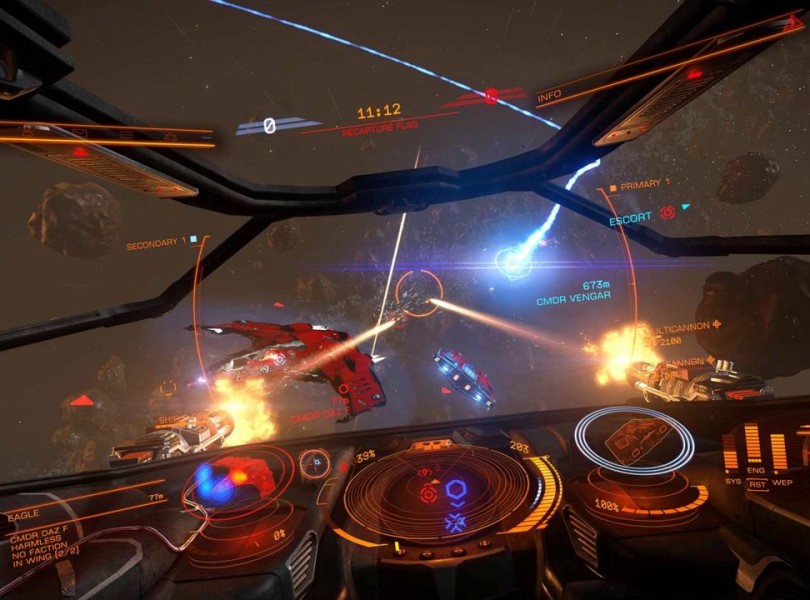I once had hopes of becoming an astronaut, but if Elite: Dangerous for the Xbox One serves as any indication, it’s probably a good thing that little dream didn’t pan out. I spent around 20 minutes crashing into hulls before I managed to dock my ship. I overshot my destinations in space more times than I care to count. I spent five minutes blasting space barrels without even being sure if I was doing it right. And that was just the tutorial. In the actual game, Elite: Dangerous offers a massive galaxy with around 400 billion stars, all bursting with dogfights, piracy, trading opportunities, and undiscovered planets — not to mention light years of dull nothingness. Few other games so brilliantly capture the vastness of space; fewer still have mechanics so complex they inadvertently emphasize how difficult it’ll be to get us out to the stars in real life.
There’s a slightly less cumbersome way to enjoy this, of course. Elite: Dangerous has been around since last year for the PC, where the keyboard is the perfect interface for a complex array of inputs. Xbox One players may share the same galaxy and economy as their PC cousins (which is odd, considering that players on both platforms can’t actively play together), but they must experience it with all those actions crammed onto a gamepad. It’s rough, but functional. Simple D-pad combos keep key features such as landing gear within reasonable reach, and an option to bring up an in-ship HUD with menus by pressing R3 removes much of the need for acrobatic finger-work.

Elite: Dangerous is all about exploration, and it’s worth taking the time to master your spacecraft in order to access the galaxy’s many splendors. The trails of asteroids bobbing through space or the light of dawn touching the edges of a nearby planet are, at times, mesmerising in their beauty. Elite: Dangerous is filled with richly textured vistas, whose demanding effects can cause frame rates to dip, but at least they closely resemble their counterparts in the PC version. I had the most fun with Elite: Dangerous during these jaunts into the darkness of outer space, where undiscovered celestial bodies lie in wait.
Elite: Dangerous smartly adds variety by providing bulletin boards that allow like-minded explorers to deliver cargo, mine asteroids for minerals (right down to using lasers and scoops), fight wars for NPC factions, or ferry items from one station to another where they’ll fetch a better price. That comfortable rhythm satisfied me for a while, but it wasn’t long before I discovered I had far more fun spending my hours in space as a pirate and driving down my reputation with the more upstanding of the game’s factions.

I turned to piracy because that’s where I found adventure beyond the inevitable grind and the simple act of exploration. As seems to be the case with other similar space exploration games, there’s only the hint of an overarching story in play here; instead, the tales that emerge from Elite: Dangerous are largely the ones we make for ourselves. That kind of thinking has worked for the likes of EVE Online for roughly 12 years now, but it works because of that game’s extreme emphasis on cooperation. Elite: Dangerous’ missions tend to focus on NPCs, and it suffers for that absence ever so slightly. Perhaps it springs from the very distances involved.
Elite Dangerous does a good job of providing secondary activities–even if they lack of bit of personality–but much of the exploration is spent careening through the inky blackness at various speeds, which do little to alleviate the trek. “Because it’s there” served as reason enough for exploring for the first five or so hours, but after that the weight of the void started to press on me, and I found myself asking what I was doing so far out on the edge of the unknown.
There’s appeal in that, if you’re of the right mindset. Elite: Dangerous tends to cater to a very specific type of personality–one that’s OK with the routine world of trade and the joys of visiting blank spaces where no one has gone before, even if all that waits there is a new deposit of Lepidolite.There’s nothing quite like it on the Xbox One with respect to range of freedom, and it holds endless wonders if you’re bold enough to tackle the learning curve necessary to enjoy that freedom. It’s great for collectors who thrive on spending hours amassing minerals and credits or–more to my liking–an array of ships that specialize in everything from battle to long-range ventures. Even then, collecting comes into play, as you visit different stations to hunt down specific parts for upgrades.
Elite: Dangerous tends to cater to a very specific type of personality–one that’s OK with the routine world of trade and the joys of visiting blank spaces where no one has gone before.
In general, then, it’s a game for players who like things slow and steady. Yet it seems that someone at Frontier thought that type of gameplay didn’t fit well with the conventional console stereotype. To that end, the Xbox One version’s launch marks the game-wide release of the CQC (Close Quarters Combat) Championship mode, which grants you access to ships with much more punch than your piddly starter Sidewinder, and let you blast away enemy players with abandon. It’s fast. It’s tense. It’s everything the core game is not. It boasts team conflict, deathmatch, and capture-the-flag modes, and in its best moments, it reminds me enough of CCP’s highly anticipated EVE Valkyrie to scratch that itch while I wait for the real thing. It’s here where the gamepad controls perform at their best, providing a vacation set in arcade-style mayhem when the everyday business of mining and meandering grows too stale.

As with our own species’ ventures into space, though, Elite: Dangerous remains a work in progress. Massive new features such as the CQC Championship mode continue to work their way in, and additional options to visit planetary surfaces or engage in first-person combat are supposedly in the works. But Elite: Dangerous has plenty to offer at the moment if you’re of a mind to explore, fight, and trade, even if much of it demands long, occasionally doze-worthy treks into the infinite. On the other hand, the distances involved are so great that I almost never saw another player (although I should note that I chiefly played in the pre-release build), which means that I almost forgot that grouping up was an option.
True to its name, Elite: Dangerous is an intimidating beast. It’s a slow game that demands feats of patience, and it’s the kind of experience that you may leave you unwilling to call yourself anything but a rookie even after dozens of hours. Once you scale its peak, though, its chief attraction is that it lets you see and travel farther than many other games have dared to. It may lack a certain spark and its missions tend to slip into drudgery, but I keep finding myself coming back to blast off toward any star in the night sky and eventually reach it. Such possibilities satisfy the thwarted little astronaut within me, and perhaps more importantly, they kindle excitement for the possibilities of the future.


